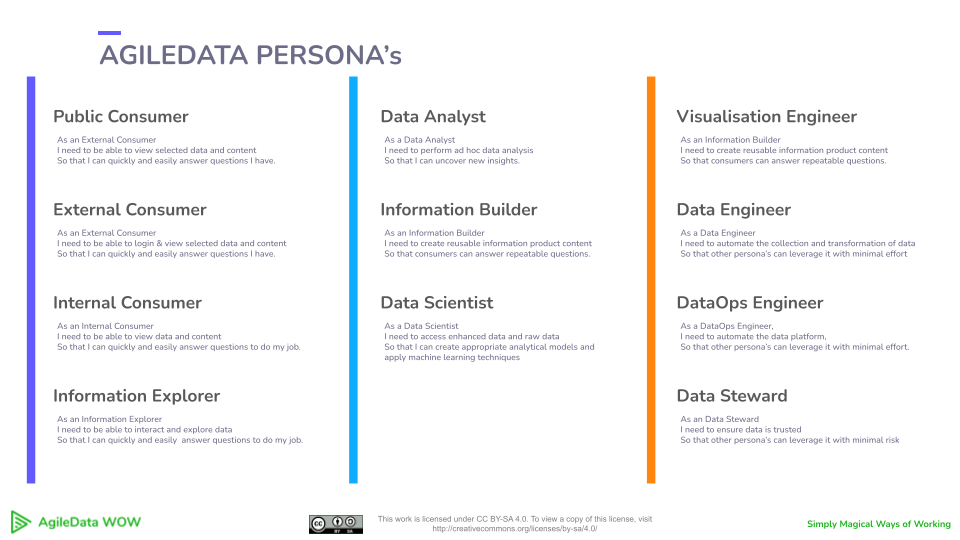AgileData Personas
We can use the same common language to identify and differentiate the group of people we are developing an Information Product or a data platform feature for.
There are a set of typical personas we see in the Data and Analytics domain:
- Public Consumer;
- External Consumer;
- Internal Consumer;
- Information Explorer;
- Data Analyst;
- Information Builder;
- Data Scientist;
- Visualisation Engineer
- Data Engineer;
- DataOps Engineer
- Data Steward.

AgileData WoW – Persona Template – Personas
These are a few common examples of personas we often see defined. As with all things AgileData you will need to tailor these persona’s to match the context of your Data Value Stream and your organisation.
The personas you define are used in other patterns, for example the Information Canvas and the data platform feature Press Release template.
<<<Need to update press release to have persona in it>>>
AgileData WoW Persona Template
The AgileData WoW Persona Template is a template we use to describe and share the definition of our AgileData Persona’s with our teams and our stakeholders..
It is designed to provide a common and shared language which enables the persona boundaries to be shared, understood and agreed with:
- stakeholders / customers
- delivery team members
- consumers of the information
Here is an example of a completed Persona Template.
You can download the AgileData WoW Persona template in a variety of formats at https://wow.agiledata.io/project/persona-template/.
The purpose of the Persona Template is to provide a way to describe a unique group of people and give that group a unique name. We find using an image or icon helps visually differentiate the different persona groups. We need a summary of the key thing the persona needs to achieve within the data domain. We need to understand where in the Data Value Stream the persona operates. We can use their level of data or tool usage and whether they prefer simple or complex user interfaces to ensure we deliver the right interfaces to them. We need to understand the action or outcome that will be undertaken with data, information or tools. We find that mapping personas to user types or roles within an organisation helps easily identify who fits within the persona group. We can use the type of data work the personas undertakes to ensure we deliver the features they need to them. We can use their preferred content delivery style, preferred access type, content focus and level of data access to ensure we deliver the right interfaces, data and information to them.
The Persona Template is a way of lightly documenting:
- The persona name;
- A summary of what they want to achieve and a visual identifier;
- The part of the Data Value Stream the persona operates within;
- The level of data or tool use and the complexity of interaction they prefer;
- The action or outcome the persona is trying to achieve;
- The typical user types in your organisation that adopts the persona;
- The type of data work the persona undertakes;
- Their preferred content delivery style, preferred access device type, content focus and level of data access.
